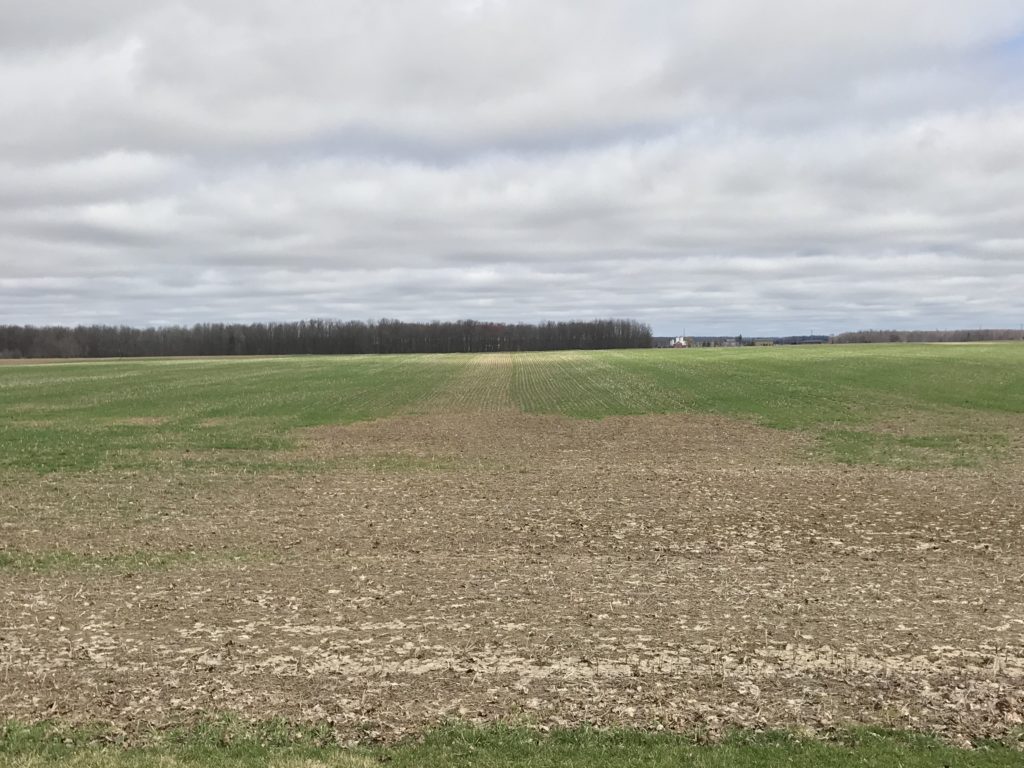Who was in attendance? 26 agricultural professionals working in the counties of Waterloo, Wellington, Huron, Grey, Bruce, Dufferin and Simcoe counties.
The past week’s weather summary: 40-50 mm of rainfall fell over the Easter weekend and understandably, field conditions are extremely wet with essentially no field activity. This will put additional pressure on livestock producers who may have significant inventories of manure waiting to be spread on fields.
Main topic of discussion: The health of the winter wheat crop was the primary focus along with what to do about areas of a field with bare patches. Group consensus was that 1/3 of the crop looks good, 1/3 of the crop is satisfactory and 1/3 of the crop is poor. In general, the best looking wheat was planted in September, a reason why planting canola and edible beans has been a nice way to ensure optimal planting of winter wheat. Excellent spread of soybean residue out the back of the combine and seed placed phosphorus were also cited as management variables that have resulted in better winter wheat stands coming out of this past winter. Very little nitrogen (N) has been applied to the winter wheat crop at this stage due to very wet soil conditions.
How much of the winter wheat crop will be terminated and planted to another crop? Estimates varied widely from 5% to 50% but most were in agreement that it could be in the 20-30% range. However, it was noted that it is still on the early side to make a definitive call since temperatures have just started to become more seasonal and the later planted winter wheat has just begun to green up. A bigger challenge is deciding on what to do with patches in the field that are dead or are in very poor condition.

Agricorp won’t penalize growers who decide to terminate part of their winter wheat field and plant it to something else: The first step when evaluating any winter wheat field is to assess stands for survival so you can decide what is worth keeping versus what should be terminated. Dealing with dead or poorly growing/thin patches in an otherwise good winter wheat field were also discussed. Each field situation is different and there are multiple considerations, some of which have been written about here. It should be noted though that many spring cereal varieties are sold out, eliminating this as an option.
What if a fall herbicide was applied to winter wheat? Typically, if a fall herbicide program is applied it will either be Eragon LQ, Infinity or Refine. If terminating a poor section of a field and planting to another crop, the risk of seeing crop injury from herbicide carryover is least when planting corn, followed by soybeans. Edible beans would be the riskiest crop to re-plant to.
Alfalfa conditions: Of the few acres evaluated, most fields appear to have overwintered well with good crown roots and some new growth occurring. However, this is based on a limited sample size and your own alfalfa fields should be monitored to evaluate winter survival since differences in soil type, drainage, topography and timing of last cut will influence winter survival.
Interesting observations: A couple of soybean fields that were harvested in January and March came off in decent shape and were of good enough quality to make grade when delivered to the elevator.
Herbicide availability: Soybean herbicides containing the active ingredient “metribuzin”(e.g. Sencor 75DF) are generally in shorter supply this year to demand in both eastern and western Canada. It would be worthwhile to discuss acreage needs with your supply to ensure it is available.
Soybean seed size and implications for seeding rates: The general sentiment from participants involved in the seed industry was that soybean seed used for planting in 2019 will be larger than normal. Larger seeds result in fewer seeds per pound and therefore requiring more soybeans (on a per weight basis) to reach the desired plant population. For example if you were targeting a seeding rate of 200,000 seeds/acre, a large seeded bean (e.g. 2,000 seeds/lbs) would require 100 lbs of seed/acre, while a small seeded bean (e.g. 2,500 seeds/lbs) would require 80 lbs of seed/acre.
Important Deadlines and Dates (Agricorp):
- May 1: New applications and coverage changes
- June 30: Spring seeded final acreage reports due
- July 10: Premiums
Upcoming Events:
- Southwest Crop Diagnostic Days (Ridgetown Campus) July 3 or 4, 2019
- FarmSmart Expo 2018 (Elora Research Station) – July 11, 2019
- Eastern Ontario Crop Diagnostic Day (Winchester Research Farm) – July 18, 2019